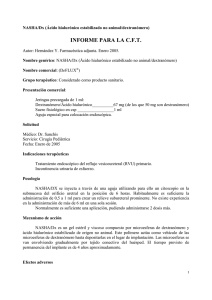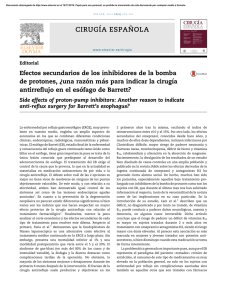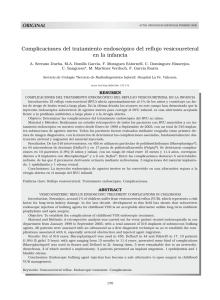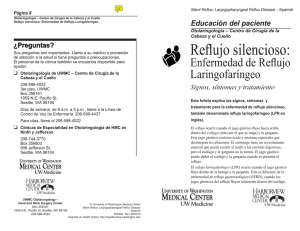Vesicoureteral Reflux - Children`s Hospitals and Clinics of Minnesota
Anuncio
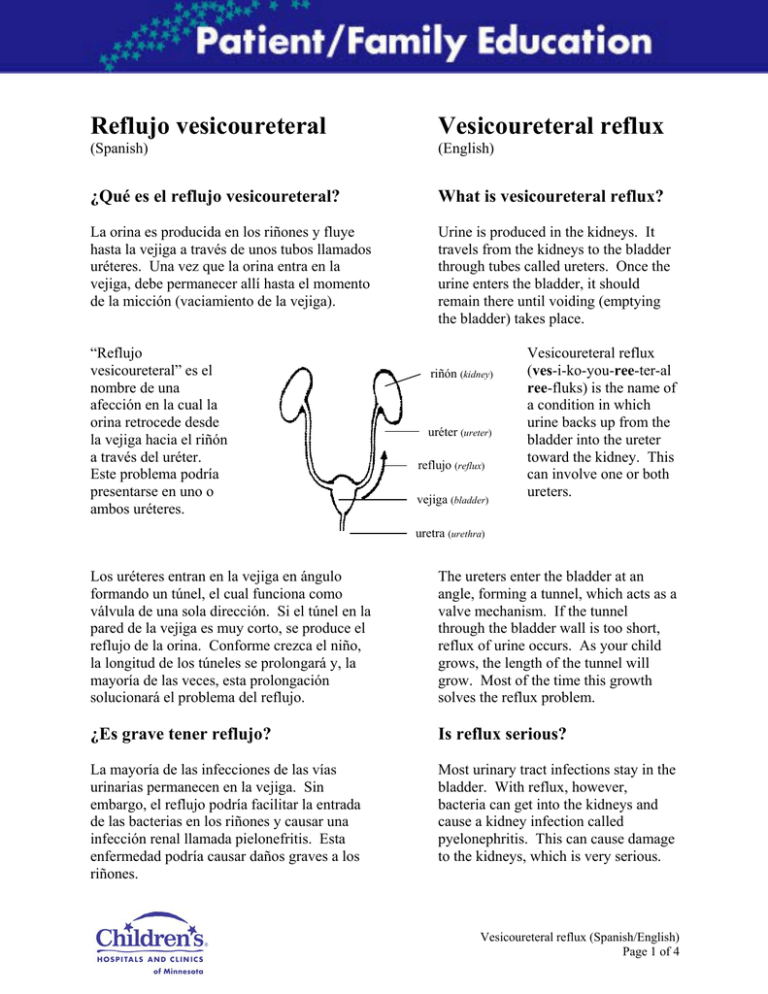
Reflujo vesicoureteral Vesicoureteral reflux (Spanish) (English) ¿Qué es el reflujo vesicoureteral? What is vesicoureteral reflux? La orina es producida en los riñones y fluye hasta la vejiga a través de unos tubos llamados uréteres. Una vez que la orina entra en la vejiga, debe permanecer allí hasta el momento de la micción (vaciamiento de la vejiga). Urine is produced in the kidneys. It travels from the kidneys to the bladder through tubes called ureters. Once the urine enters the bladder, it should remain there until voiding (emptying the bladder) takes place. “Reflujo vesicoureteral” es el nombre de una afección en la cual la orina retrocede desde la vejiga hacia el riñón a través del uréter. Este problema podría presentarse en uno o ambos uréteres. riñón (kidney) uréter (ureter) reflujo (reflux) vejiga (bladder) Vesicoureteral reflux (ves-i-ko-you-ree-ter-al ree-fluks) is the name of a condition in which urine backs up from the bladder into the ureter toward the kidney. This can involve one or both ureters. uretra (urethra) Los uréteres entran en la vejiga en ángulo formando un túnel, el cual funciona como válvula de una sola dirección. Si el túnel en la pared de la vejiga es muy corto, se produce el reflujo de la orina. Conforme crezca el niño, la longitud de los túneles se prolongará y, la mayoría de las veces, esta prolongación solucionará el problema del reflujo. The ureters enter the bladder at an angle, forming a tunnel, which acts as a valve mechanism. If the tunnel through the bladder wall is too short, reflux of urine occurs. As your child grows, the length of the tunnel will grow. Most of the time this growth solves the reflux problem. ¿Es grave tener reflujo? Is reflux serious? La mayoría de las infecciones de las vías urinarias permanecen en la vejiga. Sin embargo, el reflujo podría facilitar la entrada de las bacterias en los riñones y causar una infección renal llamada pielonefritis. Esta enfermedad podría causar daños graves a los riñones. Most urinary tract infections stay in the bladder. With reflux, however, bacteria can get into the kidneys and cause a kidney infection called pyelonephritis. This can cause damage to the kidneys, which is very serious. Vesicoureteral reflux (Spanish/English) Page 1 of 4 El reflujo se clasifica en categorías de grado I a V. En el grado I, la orina sube hasta la mitad del uréter. En los grados II a V, la orina sube por todo el uréter y entra en el riñón. La forma del uréter cambia a medida que aumenta el grado de reflujo. Grados de reflujo (Grades of reflux) I II III IV V Reflux is graded on a scale of one through five. Grade I flows part way up the ureter. Grades II through V flow all the way up the ureter and into the kidney. With higher grades the shape of the ureter changes. ¿Qué tipo de pruebas le harán al niño? What tests will my child have? Su médico decidirá si tiene que hacer una o más de las siguientes pruebas para determinar el grado de reflujo de su hijo. Este documento explica brevemente cada prueba; dispondrá de más información si hay que realizar una prueba. Your doctor will determine if one or more of the following tests need to be done to determine your child’s grade of reflux. This sheet briefly explains each test. More information is available if a test is scheduled. Dependiendo de sus edades, los hermanos de un niño con reflujo vesicoureteral podrían ser más propensos a esta afección. El médico decidirá si los hermanos necesitan alguna prueba. Depending on their age, brothers and sisters of children with vesicoureteral reflux may have an increased risk for reflux. Your doctor will decide if the siblings need any tests. Cistouretrografía miccional (CUM) Voiding cystourethrogram (VCUG) Esta prueba se realiza en el departamento de radiología (rayos X). Se inserta una sonda (pequeño tubo) hasta la vejiga, por la uretra; se administra un líquido de contraste a través de la sonda y luego se toman radiografías. Cuando la vejiga está llena, el niño orina y se toman más radiografías de la vejiga, los uréteres y los riñones. This test is done in the radiology (Xray) department. A catheter (small tube) is inserted into the bladder through the urethra. Contrast fluid is given through the catheter and X-ray pictures are taken. When the bladder is filled, your child will urinate, and more pictures will be taken of the bladder, ureters, and kidneys. Vesicoureteral reflux (Spanish/English) Page 2 of 4 Ecografía (ultrasonido renal) Renal ultrasound Esta prueba se hace para examinar los riñones, los uréteres y la vejiga a fin de detectar algún problema, sin usar catéteres ni agujas. Un técnico desplazará un transductor (aparato parecido a un pequeño micrófono) por encima del abdomen del niño. El transductor produce ondas de sonido de frecuencia ultra alta, las cuales atraviesan la parte baja del abdomen y rebotan contra la vejiga y los riñones sin causar ningún daño ni dolor. El sonido que rebota contra los riñones y la vejiga regresa con información al transductor. Esta información aparece en forma de imagen en una pantalla iluminada que el técnico observa. This test is done to look at the kidneys, ureters, and bladder to detect any problems. No catheters or needles are used. A technician will move a transducer (looks like a small microphone) across your child’s abdomen. The transducer produces ultra-high frequency sound waves, which pass painlessly and harmlessly through the lower abdomen, bouncing off the kidney and bladder. The sound that bounces off the kidney and bladder returns to the transducer with information. A picture of this information is displayed on a lighted screen for the technician to watch. Cistograma radionúclido (CR) Radionuclide cystogram (RNC) En esta prueba se utiliza equipo de medicina nuclear que administra una dosis de radiación mucho más baja que el equipo convencional de rayos X. Esta suele ser una prueba de seguimiento, que se hace en algún momento después de la primera CUM. Al igual que la CUM, esta prueba requiere el uso de un catéter que se inserta hasta la vejiga. This test uses nuclear medicine equipment that delivers a much lower dose of radiation than traditional Xrays. It is usually a follow-up test, done sometime after the first VCUG. Like the VCUG, it involves a small catheter that is inserted into the bladder. Exploración (escáner) renal Renal scan Esta prueba muestra el nivel de funcionamiento de cada riñón, o si hay cicatrices en los riñones a causa del reflujo. Para la prueba se usa una vía intravenosa (IV); además, según el tipo de exploración renal podría ser necesario usar también una sonda. This scan shows how much each kidney is functioning and any scarring of the kidneys from the reflux. Depending on the type of renal scan, a catheter may be needed. An IV is used for the test. ¿Cuál es el tratamiento? What is the treatment? La prevención de infecciones de las vías urinarias con una baja dosis de antibióticos es una de las partes más importantes del tratamiento. Es muy importante darle al niño el medicamento todos los días, de preferencia Prevention of urinary tract infections with a low dose of an antibiotic is one of the most important parts of the treatment. It is very important to give your child the medicine every day Vesicoureteral reflux (Spanish/English) Page 3 of 4 antes de dormir. Es necesario dárselo diariamente hasta que el reflujo se resuelva o sea corregido mediante una operación. (preferably at bedtime). It needs to be given daily until the reflux is resolved or corrected by surgery. Se harán pruebas cada cierto tiempo para evaluar el estado del reflujo y el crecimiento de los riñones. Conforme crezca el niño, el reflujo podría disminuir de grado o desaparecer completamente. Tests are done at intervals to check on the status of the reflux and growth of the kidneys. As your child grows, the reflux may decrease in grade or go away completely. Siempre que se le recete un tratamiento de antibióticos para alguna infección, incluida una infección urinaria, deje de darle la dosis única diaria. Después de haber terminado el tratamiento, comience nuevamente con la dosis única diaria. Anytime your child is put on an antibiotic treatment for any infection, including a urinary tract infection, stop the once-a-day dose. After treatment is over, start the once-a-day dose again. Si el niño tiene reflujo de alto grado, o si la dosis única diaria del tratamiento con antibiótico no previene las infecciones, tal vez sea necesario operarlo (vea el documento Reimplante ureteral). El médico de su hijo le explicará los planes para la operación. If your child has high-grade reflux, or the once-a-day antibiotic treatment does not prevent infections, surgery may be needed. (See the education sheet, “Ureteral reimplant”.) Your child’s doctor will discuss any surgery plans with you. ¿Tiene más preguntas? Questions? Este folleto no es específico para su hijo; sólo le ofrece información general. Si tiene alguna pregunta, llame a la clínica. This sheet is not specific to your child, but provides general information. If you have any questions, please call your clinic. Si desea más información acerca de cualquier tema relacionado con la salud, llame o visite la biblioteca del Centro de Recursos para la Familia (Family Resource Center), o visite nuestra página Web: www.childrensmn.org. For more reading material about this and other health topics, please call or visit the Family Resource Center library, or visit our Web site: www.childrensmn.org Children’s Hospitals and Clinics of Minnesota Patient/Family Education 2525 Chicago Avenue South Minneapolis, MN 55404 3/06 Copyright, Translated 7/06 Vesicoureteral reflux (Spanish/English) Page 4 of 4
